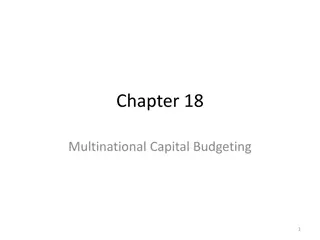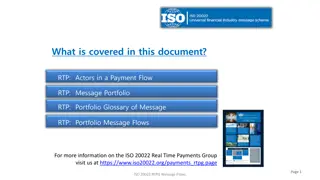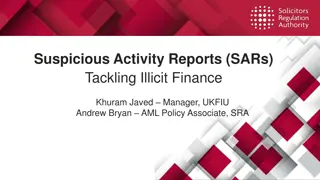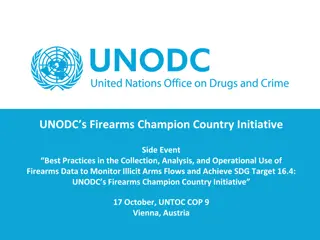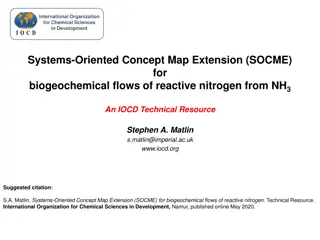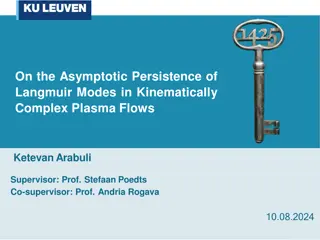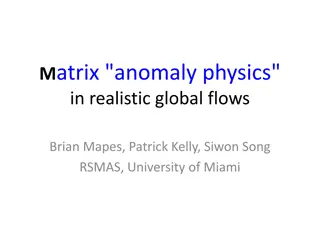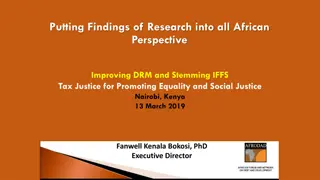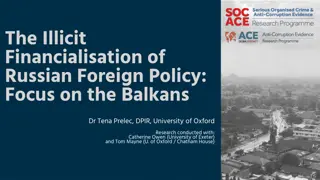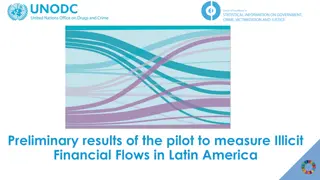Understanding Illicit Financial Flows and Their Implications
This content delves into the conceptual framework for measuring Illicit Financial Flows (IFFs), highlighting how IFFs intersect with various policy agendas such as tax evasion, corruption, and terrorism financing. It also emphasizes the importance of addressing IFFs for sustainable development, peace, and justice as outlined in the 2030 Agenda. The document distinguishes between different types of IFFs, including those originating from illegal markets and activities like corruption, exploitation, and terrorism financing.
Uploaded on Jul 23, 2024 | 1 Views
Download Presentation

Please find below an Image/Link to download the presentation.
The content on the website is provided AS IS for your information and personal use only. It may not be sold, licensed, or shared on other websites without obtaining consent from the author. Download presentation by click this link. If you encounter any issues during the download, it is possible that the publisher has removed the file from their server.
E N D
Presentation Transcript
UNCTAD-UNODC Conceptual framework for the statistical measurement of Illicit Financial Flows Enrico Bisogno Chief, Data Development and Dissemination Section UNODC
IFFs at the crossroad of multiple policy agendas Instrument for tax evasion or avoidance loss of public resources Instrument for committing/facilitating corruption rule of law erosion Vehicle to foster illegal markets or invest related proceeds weakening of justice system and rule of law threat to state security Vehicle to finance terrorism 2
The framework: 2030 Agenda Goal 16 Promote peaceful and inclusive societies for sustainable development, provide access to justice for all and build effective, accountable and inclusive institutions at all levels Target 16.4: By 2030, significantly reduce illicit financial and arms flows, strengthen the recovery and return of stolen assets and combat all forms of organized crime Indicator 16.4.1: Total value of inward and outward illicit financial flows (in current US Dollars) UNODC and UNCTAD, as co-custodians of indicator 16.4.1, are mandated to develop the statistical methodology 3
IFFs for statistical purposes Monetary measure of: International transfers of illicitly earned capital (Originally) legal capital transferred internationally for illicit purposes (Originally) legal capital transferred illicitly Core Elements: Flows Flows no stocks no stocks no net flows no net flows Cross Cross- -Border Border not domestic not domestic Illicit Illicit 4
IFFs from illegal markets/activities Corruption Exploitation-type and terrorism financing Illegal markets Kidnapping Kidnapping Slavery and exploitation Slavery and exploitation Trafficking in persons Trafficking in persons Sexual exploitation Sexual exploitation Extortion Extortion Robbery Robbery Burglary Burglary Theft Theft Financing of terrorism Financing of terrorism Drug trafficking Drug trafficking Firearm trafficking Firearm trafficking Illegal mining Illegal mining Smuggling of migrants Smuggling of migrants Smuggling of goods Smuggling of goods Wildlife trafficking Wildlife trafficking Bribery Bribery Embezzlement Embezzlement Abuse of functions Abuse of functions Trading in influence Trading in influence Illicit enrichment Illicit enrichment Other acts of corruption Other acts of corruption Productive activities Non productive activities 6
Example: IFFs emerging from drug trafficking Drug importing and consumption country IFF IFF Drug processing, wholesale and retail sale Value is generated 7
Dual Focus in Measuring IFFs Income Generation Income Management Illicit financial flows connected to illicit markets and their functioning Illicit financial flows to manage income generated from illicit activities Linked to transnational supply and demand of illicit goods and services Linked to consumption and investment patterns of illicit actors 8
IFF from opiates trafficking, Afghanistan (income generation) 9
Statistical Framework for Measuring IFFs Key features: Country-Level: Allows to measure IFFs at the level of countries (in line with SDG indicator framework) Disaggregated: separate estimates for each IFF type Comprehensive: Encompasses main types of illicit activities that cause IFFs Compatible: Aligned to established concepts and standards from economics and accounting 10


